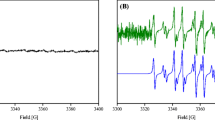Abstract
Lipid oxidation is one of the major causes of oil deterioration causing off-flavors and consumer rejection. Fast, easy, and dependable assays for predicting lipid oxidation rates in foods are important for shelf-life prediction. In this study, an electron paramagnetic resonance (EPR) spin-trapping technique with N-tert-butyl-α-phenylnitrone (PBN) was tested to determine the lag phase of lipid oxidation in stripped soybean oil (SSO), SSO with added α-tocopherol, and commercial soybean, canola and corn oils. EPR intensity of spin-trapped products from SSO correlated well with lipid hydroperoxides formation for samples stored at 37 and 55 °C respectively. When the antioxidant α-tocopherol was added, the EPR signal intensity of oil samples increased—indicating sample deterioration—after 50–65% of α-tocopherol was consumed. When using the EPR method with commercial soybean, canola or corn oil stored at 55 °C, there was a poor relationship between EPR intensity and lipid hydroperoxides lag phases. However, a linear correlation was found between EPR signal intensity and hexanal formation. For example, EPR signal intensity lag phases were 5, 13 and 27 days for soybean, canola and corn oils, respectively which was similar to the hexanal lag phases of 5, 13 and 25 days for the same oils. The EPR spin-trapping assay method has several advantages over headspace hexanal measurements, especially with regard to easier sample handling and shorter analysis times.






Similar content being viewed by others
References
Damodaran S, Parkin KL (2008) Fennema’s food chemistry, vol 4. CRC Press Boca Raton, FL
Frankel EN (1984) Lipid oxidation: mechanisms, products and biological significance. J Am Oil Chem Soc 61(12):1908–1917
Chaiyasit W, Elias RJ, McClements DJ, Decker EA (2007) Role of physical structures in bulk oils on lipid oxidation. Crit Rev Food Sci 47(3):299–317
Kerrihard AL, Pegg RB, Sarkar A, Craft BD (2015) Update on the methods for monitoring UFA oxidation in food products. Eur J Lipid Sci Technol 117(1):1–14
Roman O, Maillard M-N, Plessis C, Riquet A-M (2010) Electron spin resonance spectroscopy: a promising method for studying lipid oxidation in foods. Lipid Technology 22(4):87–90
Velasco J, Andersen ML, Skibsted LH (2005) Electron Spin Resonance Spin Trapping for Analysis of Lipid Oxidation in Oils: inhibiting Effect of the Spin Trap α-Phenyl-N-tert-butylnitrone on Lipid Oxidation. J Agr Food Chem 53(5):1328–1336
Papadimitriou V, Sotiroudis TG, Xenakis A, Sofikiti N, Stavyiannoudaki V, Chaniotakis NA (2006) Oxidative stability and radical scavenging activity of extra virgin olive oils: an electron paramagnetic resonance spectroscopy study. Anal Chim Acta 573–574:453–458
Ricca M, Fodera V, Vetri V, Buscarino G, Montalbano M, Leone M (2012) Oxidation processes in Sicilian olive oils investigated by a combination of optical and EPR spectroscopy. J Food Sci 77(10):C1084–C1089
Velasco JN, Andersen ML, Skibsted LH (2004) Evaluation of oxidative stability of vegetable oils by monitoring the tendency to radical formation. A comparison of electron spin resonance spectroscopy with the Rancimat method and differential scanning calorimetry. Food Chem 85(4):623–632
Thomsen M, Kristensen D, Skibsted L (2000) Electron spin resonance spectroscopy for determination of the oxidative stability of food lipids. J Amer Oil Chem Soc 77(7):725–730
Bruker Corporation (2016) https://www.bruker.com/products/mr/epr/e-scan/beer-analyzer/technical-details.html. Accessed 23 Aug 2016
Cui L, McClements DJ, Decker EA (2015) Impact of phosphatidylethanolamine on the antioxidant activity of α-Tocopherol and Trolox in bulk oil. J Agr Food Chem 63(12):3288–3294
Association of Official Analytical Chemists (AOAC): Polar components in frying fats. AOAC press, Official Method 982.27, Chapter 41.1.34
Shantha NC, Decker EA (1994) Rapid, sensitive, iron-based spectrophotometric methods for determination of peroxide values of food lipids. J AOAC Int 77(2):421–424
Chen B, Han A, McClements DJ, Decker EA (2010) Physical structures in soybean oil and their impact on lipid oxidation. J Agric Food Chem 58(22):11993–11999
O’Keefe S, Pike O (2010) Fat characterization. Food analysis. Springer, New York, pp 239–260
Fujino H, Ukai M (2013) Fat and oil oxidation by electron spin resonance (ESR) spin-trapping method. J Food Sci Eng 3(11):584
Chen B, McClements DJ, Decker EA (2011) Minor components in food oils: a critical review of their roles on lipid oxidation chemistry in bulk oils and emulsions. Crit Rev Food Sci Nutr 51(10):901–916
Cui L, Decker EA (2015) Phospholipids in foods: prooxidants or antioxidants? J Sci Food Agric 96(1):18–31
Shahidi F, Zhong Y (2010) Lipid oxidation and improving the oxidative stability. Chem Soc Rev 39(11):4067–4079
Yamamoto K, Niki E (1988) Interaction of α-tocopherol with iron: antioxidant and prooxidant effects of α-tocopherol in the oxidation of lipids in aqueous dispersions in the presence of iron. Biochimica et Biophysica Acta (BBA)—Lipids and Lipid. Metabolism 958(1):19–23
Naumov VV, Vasil’ev RF (2003) Antioxidant and prooxidant effects of tocopherol. Kinet Catal+ 44(1):101–105
Jerzykiewicz M, Cwielag-Piasecka I, Jezierski A (2013) Pro- and antioxidative effect of alpha-tocopherol on edible oils, triglycerides and fatty acids. J Am Oil Chem Soc 90(6):803–811
Akoh CC, Min DB (2008) Food lipids: chemistry, nutrition, and biotechnology. CRC Press, Boca Raton
Evans JC, Kodali DR, Addis PB (2002) Optimal tocopherol concentrations to inhibit soybean oil oxidation. J Amer Oil Chem Soc 79(1):47–51
Ouchi A, Ishikura M, Konishi K, Nagaoka S, Mukai K (2009) Kinetic study of the prooxidant effect of α-tocopherol. Hydrogen abstraction from lipids by α-tocopheroxyl radical. Lipids 44(10):935
Acknowledgements
We would like to thank Bruker BioSpin Corporation for the extended loan of the Biospin e-scan EPR spectrometer which enabled us to conduct this research. This work is partially supported by the National Natural Science Foundation of China (No. 31601546).
Author information
Authors and Affiliations
Corresponding author
About this article
Cite this article
Cui, L., Lahti, P.M. & Decker, E.A. Evaluating Electron Paramagnetic Resonance (EPR) to Measure Lipid Oxidation Lag Phase for Shelf-Life Determination of Oils. J Am Oil Chem Soc 94, 89–97 (2017). https://doi.org/10.1007/s11746-016-2927-1
Received:
Revised:
Accepted:
Published:
Issue Date:
DOI: https://doi.org/10.1007/s11746-016-2927-1




